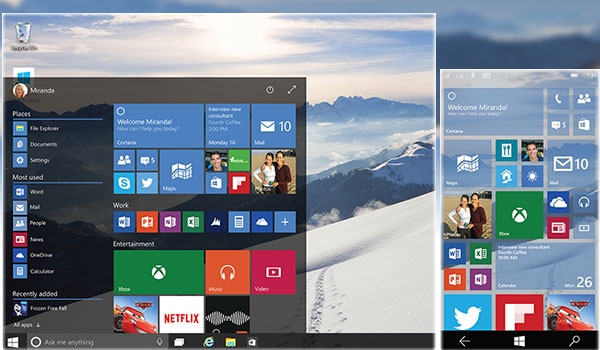What I find most interesting about Windows 10 is that if Apple wanted to knock Microsoft off the desktop, then it — not Microsoft — should have released a product like this. When I say “like this,” I mean one that could transform a smartphone into a PC.
My reasoning is that Microsoft is relatively weak in smartphones, and Apple currently is kicking Google all over the market. Given Google’s power, that’s pretty impressive — of course, it is also largely Google’s own fault.
Granted, Apple would have to lead with iOS, not OS X, but given Apple’s massive mobile power, the result could be devastating. However, Apple won’t go that route, because it effectively would eliminate its PC sales, and it wants both revenue streams. That gives Microsoft a unique lever if — and this is a big if — it can figure out a way to use it.
I’ll focus on that this week and end with my product of the week: a new very low-cost video conferencing system from AVer.
The Windows 10 Lever
There are undoubtedly a few million more people on Windows 10 this week than there were last week, thanks to the launch of the product. There is some breakage in the upgrade, but given the massive number of folks who made this move, it has been unusually light.
The most powerful part of this product isn’t the UI fix, the various features, or the product’s speed and security. It is the fact it runs on both tablets and PCs and will run on smartphones.
What this means is that at some point — and this was demonstrated — you could build a smartphone that effectively could become a PC. All you’d have to do is add a keyboard, mouse and monitor.
Tied to a back-end service like Frame or Dell Cloud Connect (both based on Nvidia Grid) you could have a solution that neither Apple nor Google could match: a secure, fully featured desktop client — with power that would scale from simple tasks to full-on workstation performance — that would fit in your pocket.
Think how wonderful that would be. Your smartphone becomes your PC, and it effectively morphs based on what you attach to it. Granted, it would mean rethinking laptops as more portable keyboards/trackpads/screens than PCs, but the end result could enable a massive transformation in the market, which would take the multiple products we now carry and turn them into one product that we’d accessorize.
If Microsoft were to bring that to fruition, it would render PCs and smartphones as we know them obsolete — and that potentially would provide a path back to dominance and relevance.
Apple Is Better Positioned
However, this strategy moves up from smartphones, not down from PCs. I’m not envisioning taking a PC and turning it into a smartphone, but rather turning a smartphone into a PC, and that means it would be best to start with a strong position in smartphones. That is what Apple has and Microsoft lacks, which means that if Apple were to do the same thing with iOS, it could displace Microsoft more easily than Microsoft could displace Apple. But it won’t.
That’s because Apple’s model is based on customers buying a lot of products from Apple — not just one — and as a result, it will be unwilling to abandon OS X in favor of iOS for fear of losing all or most of its PC revenue. There clearly would be an offset for new accessories, but Apple isn’t thinking about collapsing its product line.
It is working on increasing it, and the Apple Watch implementation is an example. It could have been a phone replacement product — but instead it’s an accessory, so you need to buy the watch and the phone.
So, while Apple could execute a very similar strategy and do more damage to Microsoft than Microsoft initially could do to Apple — it won’t.
Why Not Google?
Oh, and while Google could do this as well, the father of Chrome OS is running its operating system business. He’d have to replace Chrome OS with Android — and no one gives up his own product that easily.
So, Google is out of this chase as well. The company has been considering a converged OS platform — but Android is already in trouble. If a pivot to a new OS were executed badly, it could knock Google out of the market. Developers have been complaining that they haven’t been making money on Android for some time, suggesting that many might not spend the money to migrate their products to a new OS.
So, even though Google could do this, its developer foundation may not be solid enough to make the pivot it would have to make. Also, the pivot it should make — off Android — is distasteful.
Android is under a bit of an ugly cloud at the moment. Most of the firms I work with appear to be losing money on the platform, and its security issues are legion, providing an unprecedented opportunity for both Apple and Microsoft (not to mention BlackBerry).
Microsoft’s Reverse Pivot
So, Microsoft, rather than using the smartphone to take over PCs, is on the more difficult path of using the PC to take over the smartphone. The best way to do this would be to partner with Intel again to make the move, given that Intel also is spending a fortune to penetrate the smartphone segment. With their combined resources, the firms could fund a massive effort.
There has been an historic feud going on between Intel and Microsoft. However, with the replacement of both CEOs, there now is a great opportunity for them to come together, much like they did when the PC was born, to once again redefine personal computing as mostly mobile. (Well, the market kind of already did that, but I mean on Intel and Microsoft technology — not on ARM and Apple tech).
Windows 10 is the best shot Microsoft has had this decade to take tech market momentum back from Apple.
Wrapping Up
Microsoft’s strategy of using its PC position to attack smartphones is a good one; it’s just that both Apple and Google are in better positions to pull off the opposite. Both are stronger on the target smartphone platform today — although Google’s strength is falling like a rock at the moment.
This battle likely will be defined more by what these vendors choose not to do than what they choose to do. Microsoft will have to push smartphones harder than it ever has and get powerful help from someone like Intel to pull it off — and it might not.
Apple would have to accept the cannibalization of Macs by iPhones, and it really won’t want to do that.
Google would have to fix its developer problems or pivot off Android, not the Chrome OS, and it likely won’t do that either.
In the end, the future most likely will belong to the company with the balls to take the big risk (or the one that is already dominant). Google, not Apple, is the most at risk. The next few years should be really interesting.
Video conferencing is a fascinating segment. I got my first glimpse of this technology in the mid-1960s at Disneyland. Today, even with FaceTime, folks rarely use this technology personally. Nor is it often used in meetings, even though it has become far cheaper and easier to use.
A good example of this is the new AVer VC 520, which includes a decent speakerphone and panning/zooming high-definition camera for conference room use and costs under US$1,000. You then add an HDTV, (you can get a Vizio 50-inch TV for about $500), and you have a system that rivals some that sold for $20K a few years ago. It works with Skype, Microsoft Lync, Google Hangouts, Cisco WebEx, GoToMeeting and WebRTC.

I’ve been playing with one of these for a week, and setup was relatively easy for a component system. I really didn’t even need to install its software with Windows 10 — the system just connected to Skype, which is what I generally use, and I was off to the races.
Speakerphone and image quality were in line with other HD systems, including the old $100K HP Halo units we were using five years ago. It is amazing how far these things have come in a short period of time.
Skype was able to control the camera remotely just fine. WebEx has been breaking a lot of late, so I don’t use it anymore. I haven’t used GoToMeeting or Google Hangouts for some time. Currently I mostly live on Skype or Lync, because they just work.
It continues to impress me how much this technology has advanced over the years, and because the AVer VC 520 is a showcase of how far we have come in quality and price, it’s perfect for my product of the week.

























































